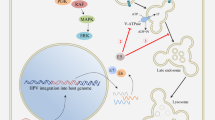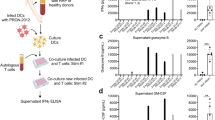Abstract
Human papillomavirus (HPV) is the etiologic agent for cervical cancer. In Mexico, a women dies every 2 h, and since 1990 the statistics have shown that the numbers of deaths are increasing. We conducted a phase II clinical trial to evaluate the potential use of the MVA E2 recombinant vaccinia virus in treating high-grade lesions (CIN 2 and CIN 3) associated with oncogenic papillomavirus. Fifty-four female patients with high degree lesions were treated either with an MVA E2 therapeutic vaccine or with conization. Thirty-four women received the therapeutic vaccine, at a total of 107 virus particles per dose injected directly into the uterus once every week over a 6-week period. Twenty control patients were treated with conization. By colposcopy, 19 patients out of 34 showed no lesion, in three patients the lesions were reduced by 85–90%, in eight other lesions had reduced by 60%, and in four more patients, they were reduced by 25%. Histological analysis showed total elimination of high-grade lesions in 20 out of 34 patients after treatment with MVA E2. Eleven patients had a 50% reduction in lesion size. In two other patients, the lesion was reduced to CIN 2 and in one more patient the lesion was reduced to low grade (CIN 1). All patients developed antibodies against the MVA E2 vaccine, and generated a specific cytotoxic response against papilloma-transformed cells. DNA viral load was significantly reduced in MVA E2-treated patients. Conization eliminated the lesions in 80% of the patients, but patients did not develop cytotoxic activity specific against cancer cells and did not eliminate the papillomavirus. In addition, three patients treated with conization had recurrence of lesions 1 year later. These results show that therapeutic vaccination with MVA E2 proved to be very effective in stimulating the immune system against papillomavirus, and in generating regression of high-grade lesion.
This is a preview of subscription content, access via your institution
Access options
Subscribe to this journal
Receive 12 print issues and online access
$259.00 per year
only $21.58 per issue
Buy this article
- Purchase on Springer Link
- Instant access to full article PDF
Prices may be subject to local taxes which are calculated during checkout

Similar content being viewed by others
References
Jansen K, Shaw A . Human papillomavirus vaccines and prevention of cervical cancer. Ann Rev Med 2004; 55: 319–331.
Parkin DM, Laara E, Muir CS . Estimates of the world-wide frequency of sixteen major cancers in 1980. Int J Cancer 1980; 41: 184–197.
Rosales C, Valadez G, Arrellin R, Merchant H, Rosales R . A recombinant vaccinia virus containing the papilloma E2 protein promotes tumor regression by stimulating macrophage antibody-dependent cytotoxicity. Cancer Immunol Immunother 2000; 49: 347–360.
Valadez V, Sutter G, Jose M, Garcia-Carranca A, Erfle V, Moreno M et al. Human tumor growth is inhibited by vaccinia virus carrying the E2 gene of bovine papillomavirus. Cancer 2000; 88: 1650.
Corona-Gutiérrez C, Tinoco A, Contreras M, Navarro T, Calzado P, Vargas L et al. A phase II study. Efficacy of the gene therapy of the MVA E2 recombinant virus in the treatment of precancerous lesions (NIC I and NIC II) associated with infection of oncogenic human papillomavirus. Hum Gene Ther 2002; 13: 1127–1140.
Corona-Gutiérrez C, Tinoco A, Navarro T, López-Contreras M, Risco-Cortes R, Calzado P et al. Therapeutic vaccination with MVA E2 can eliminate precancerous lesions (CIN 1, CIN 2 and CIN 3) associated with infection by oncogenic human papillomavirus. Hum Gene Ther 2004; 15: 421–431.
Binns MM, Smith GL . Recombinant Poxvirus. ACR Press: Boca Raton, Florida, 1993.
Sutter G, Wyatt LS, Foley PL, Bennick JR, Moss B . A recombinant vector derived from the host range-restricted and highly attenuated MVA strain of vaccinia virus stimulates protective immunity in mice to influenza virus. Vaccine 1994; 12: 53–59.
Roque-Reséndiz J, Rosales R, Herion P . MVA ROP 2 vaccinia virus recombinant as a vaccine candidate for toxoplasmosis. Parasitology 2004; 128: 397–405.
Hanke T, McMichael A, Mwau M, Wee EG, Ceberej I, Patel S et al. Development of a DNA-MVA/HIVA vaccine for Kenya. Vaccine 2002; 20: 1995–1998.
Wyatt L, Whitehead S, Venanzi K, Murphy B, Moss B . Priming and boosting immunity to respiratory syncytial virus by recombinant replication-defective vaccinia virus MVA. Vaccine 1999; 18: 392–397.
Author information
Authors and Affiliations
Corresponding author
Rights and permissions
About this article
Cite this article
García-Hernández, E., González-Sánchez, J., Andrade-Manzano, A. et al. Regression of papilloma high-grade lesions (CIN 2 and CIN 3) is stimulated by therapeutic vaccination with MVA E2 recombinant vaccine. Cancer Gene Ther 13, 592–597 (2006). https://doi.org/10.1038/sj.cgt.7700937
Received:
Revised:
Accepted:
Published:
Issue Date:
DOI: https://doi.org/10.1038/sj.cgt.7700937
Keywords
This article is cited by
-
Therapeutic options for treatment of human papillomavirus-associated cancers - novel immunologic vaccines: ADXS11–001
Gynecologic Oncology Research and Practice (2017)
-
Construction d’un vecteur d’expression chez Lactococcus lactis basée sur la production d’une protéine ancrée de Papillomavirus humain 16 E2/E7
Journal Africain du Cancer / African Journal of Cancer (2015)
-
Immunologic treatments for precancerous lesions and uterine cervical cancer
Journal of Experimental & Clinical Cancer Research (2014)
-
Cervical Cancer: Development of Targeted Therapies Beyond Molecular Pathogenesis
Current Obstetrics and Gynecology Reports (2014)
-
Clearance of persistent HPV infection and cervical lesion by therapeutic DNA vaccine in CIN3 patients
Nature Communications (2014)



